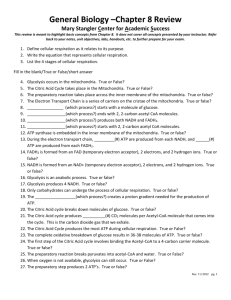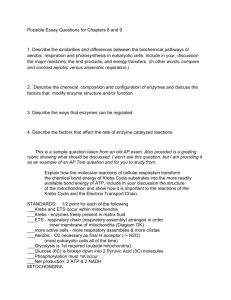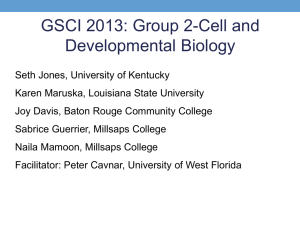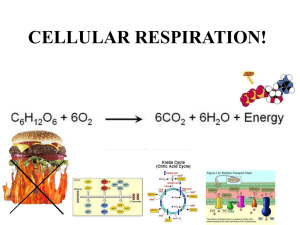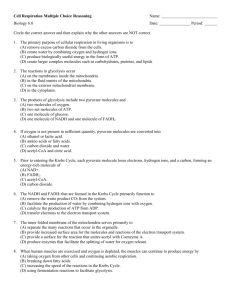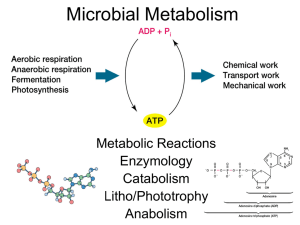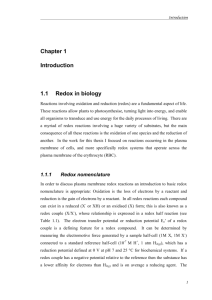Ch19Pt1+2
advertisement
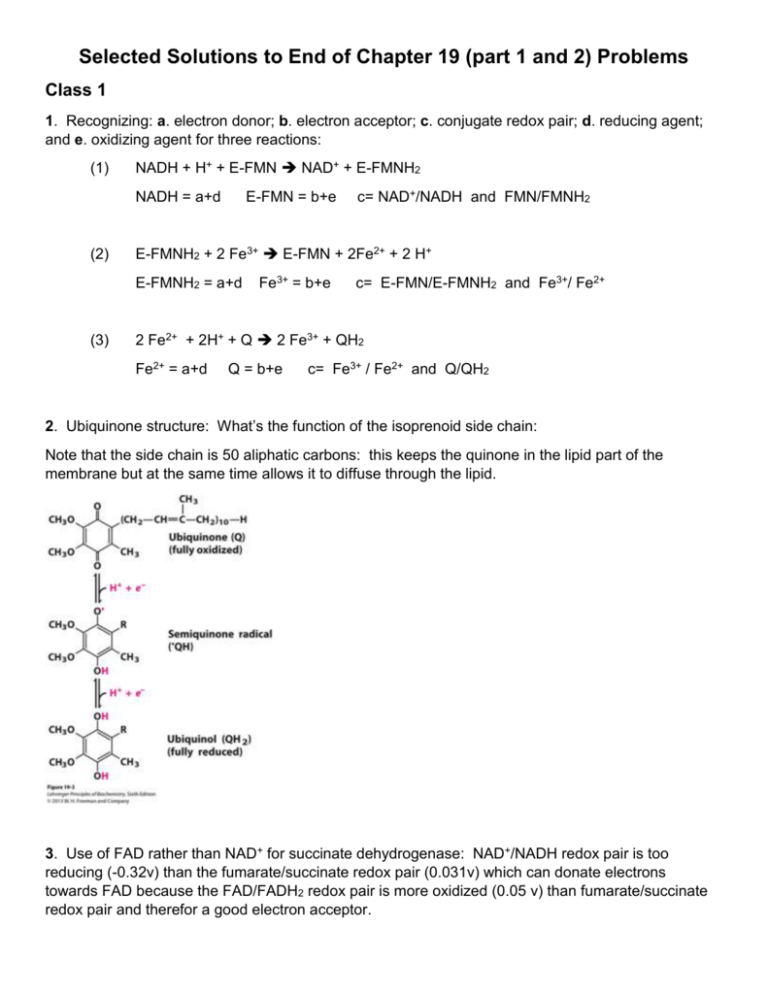
Selected Solutions to End of Chapter 19 (part 1 and 2) Problems Class 1 1. Recognizing: a. electron donor; b. electron acceptor; c. conjugate redox pair; d. reducing agent; and e. oxidizing agent for three reactions: (1) NADH + H+ + E-FMN NAD+ + E-FMNH2 NADH = a+d (2) E-FMN = b+e E-FMNH2 + 2 Fe3+ E-FMN + 2Fe2+ + 2 H+ E-FMNH2 = a+d (3) c= NAD+/NADH and FMN/FMNH2 Fe3+ = b+e c= E-FMN/E-FMNH2 and Fe3+/ Fe2+ 2 Fe2+ + 2H+ + Q 2 Fe3+ + QH2 Fe2+ = a+d Q = b+e c= Fe3+ / Fe2+ and Q/QH2 2. Ubiquinone structure: What’s the function of the isoprenoid side chain: Note that the side chain is 50 aliphatic carbons: this keeps the quinone in the lipid part of the membrane but at the same time allows it to diffuse through the lipid. 3. Use of FAD rather than NAD+ for succinate dehydrogenase: NAD+/NADH redox pair is too reducing (-0.32v) than the fumarate/succinate redox pair (0.031v) which can donate electrons towards FAD because the FAD/FADH2 redox pair is more oxidized (0.05 v) than fumarate/succinate redox pair and therefor a good electron acceptor. 4. Degree of reduction of respiratory electron carriers: predict the redox state of ubiquinone, cytochromes b, c1, c and a+a3. Lets make it a table: Conditions Abundant NADH + O2, CN- added Abundant NADH, exhausted O2 Abundant O2 NADH exhausted Abundant O2 and NADH Ubi-Q red red oxi red Cyt-b red red oxi Less red Cyt-c1 red red oxi +/- red/oxi Cyt-c red red oxi oxi Cyt a+a3 red red oxi oxi 5. Effects of Rotenone (a plant product) and Antimycin A (a toxic antibiotic). Rotenone inhibits NADH oxidase, Antimycin-A inhibits oxidation of ubiquinol. a. Why is rotenone lethal? It stops electron transport beginning from NADH, but not from FADH2. It slowly brings about death because FADH2 can not support a proton motive force to supply all the ATP required for life. b. Why is antimycin-A toxic? It stops electron transport at ubiquinone. This stops electron transport from both NADH and FADH2. c. Which is the more potent toxin? Antimycin because it blocks all electron transport from both NADH and FADH2. Class 2 6. Oxidative Phosphorylation uncouplers: predict the P/O ratios when: a. Low concentration of uncouplers will lower the P/O ratio because the uncouplers allow protons from the exterior of the respiratory membrane to enter the matrix of the mitochondria. This simply makes electron transport less efficient. At high concentration of the uncoupler, the P/O ratio goes to zero. b. Ingestion of uncouplers causing a rise in body temperature with profuse sweating. This is caused by the release of energy as heat when the uncouplers facilitate the loss of energy of the proton motive force: PMF not generating ATP, but is generating heat. c. 2,4 dinitrophenol was once prescribed as a weight reducing drug. This works because the P/O ratio is lowered and the body uses up it’s fat reserves in order to produce ATP. A highly dangerous treatment for some that over react and shut down their production of ATP (P/O ratio hits zero and death). 7. Valinomycin is an uncoupler by acting as a K+ ionophore to decrease the electrical potential across the membrane. ATP synthesis decreases which stimulates electron transport thereby increases the [H+] chemical gradient, oxygen consumption and releases heat. 9. Why is malate dehydrogenase found both inside the mitochondria (as part of CAC) but also in the cytoplasm? What is it doing in the cytoplasm? It is part of the malate-aspartate shuttle that transfers NADH equivalents from the cytoplasm to the matrix of the mitochondria. (see Fig 19-31). 10. An inhibitor of the malate-αketoglutarate transporter is n-butylmalonate. What is the effect of this inhibitor on kidney cells using glucose as their source of energy? This inhibitor blocks the exchange of malate (going in) and αketoglutarate (going out) across the mitochondrial membrane. So it’s effect on: a. Glycolysis: makes it go anaerobic style. The excess NADH in the cytoplasm will increase the reduction of pyruvate to lactic acid instead to getting pyruvate into the mitochondria. b. Oxygen consumption decreases. c. Lactate concentration goes up. d. ATP synthesis then relies on the 2 ATP per glucose from glycolysis. 11. Cellular ADP controls rate of ATP synthesis in mitochondria. Both ADP and Pi are needed for ATP synthesis, but it is [ADP] that regulates ATP synthesis because [P i] is fairly high and change in it does not really reflect metabolic changes as much as changes in [ADP]. 13. The Pasteur Effect. Louis Pasteur found that cells growing anaerobically with glucose use glucose at a high rate and that when growing with oxygen, aerobically, consume glucose at a lower rate. a. Why does the production of lactate stop after adding oxygen to an anaerobic culture? Because these cells can now respire and get more ATP per glucose. So instead of fermenting pyruvate to lactate, they can put the pyruvate through the CAC and electron transport to get more ATP per glucose than through fermentation. b. Why does oxygen decrease glucose consumption? A little does a lot more aerobically. c. see “a” above and the increased ATP production inhibits phosphofructokinase-1 slowing down glycolysis. 14. “Petit” mutants of yeasts have a defective cytochrome oxidase (cytochrome a/a 3 complex does not function) consequently they form “small” colonies. These mutants lack the Pasteur Effect and some companies are interested in using these to produce alcohol from wood chips. What are the advantages of these mutants for ethanol production? The advantage is that they would not need special anaerobic equipment to produce alcohol. Wild type yeast require anaerobic conditions that are expensive to maintain. Why does the absence of cytochrome oxidase eliminate the Pasteur effect? Pasteur effect needs both the CAC and electron transport to be operative. Anaerobes still need a little CAC to provide intermediates for biosynthesis, but not for energy production. 16. How many protons? Data: pH of external media = 7.4; pH of the mitochondrial matrix = 7.7 a. [H+] outside and inside the mitochondria is? (Hey gals and guys, back to Chapter 1 and 2). Outside the mitochondria [H+] = 10-7.4 M = 3.98 x 10-8 M round off to 4 x 10-8 M; inside the mitochondria [H+] = 10-7.7 M = 2 x 10-8 M. b. The change in pH from outside to inside is just part of the energy difference in the proton motive force: PMF ΔGo’ = RT ln (C2 / C1) + ZF ΔΨ PMF ΔGo’ = RT ln (C2 / C1) + ZF ΔΨ = chemical energy + electrical energy The inside outside ratio contribution to the PMF ΔGo’ = RT ln ( 2 x 10-8 / 4 x 10-8) ΔGo’ = 2.48 kJ/mole (- 0.69) = -1.7 kJ/mole which is likely not enough to make ATP by the concentration difference alone….we can calculate the number of protons on the inside, next. c. Protons in mitochondrial matrix: calculate as a sphere, 1.5 μm diameter. Volume of the mitochondrial matrix vol = 4/3 π r3 = 4/3 (3.14) (0.75 x 10-6 m)3 = 1.76 x 10-18 m3 = 1.76 x 10-15 L inside the mitochondria, [H+] = 2 x 10-8 moles/L so 2 x 20-8 moles / L x 1.76 x 10-15 L = 3.52 x 10-23 moles # H molecules, then: 3.5 x 10-23 mole x 6.02 x 1023 molecules/mole = 21 protons d. Is the pH gradient enough. No. e. The rest is made up by the membrane potential, the electrical difference between the outside and the mitochondrial matrix.

